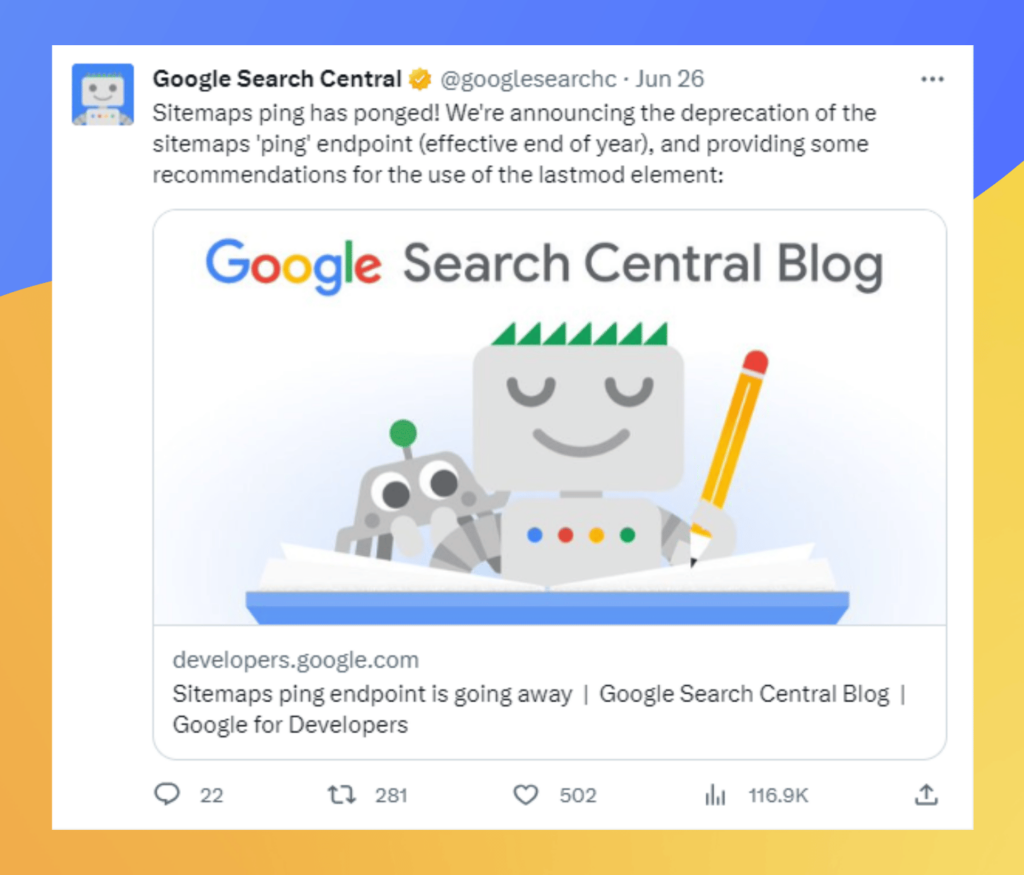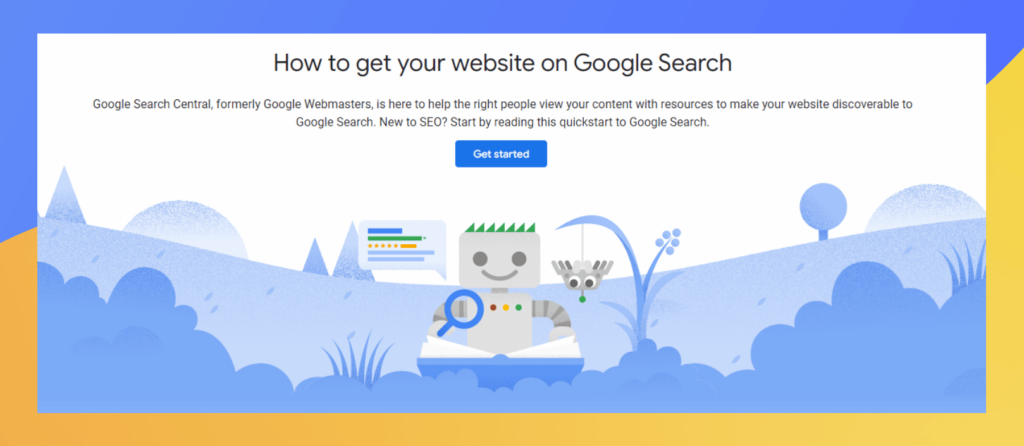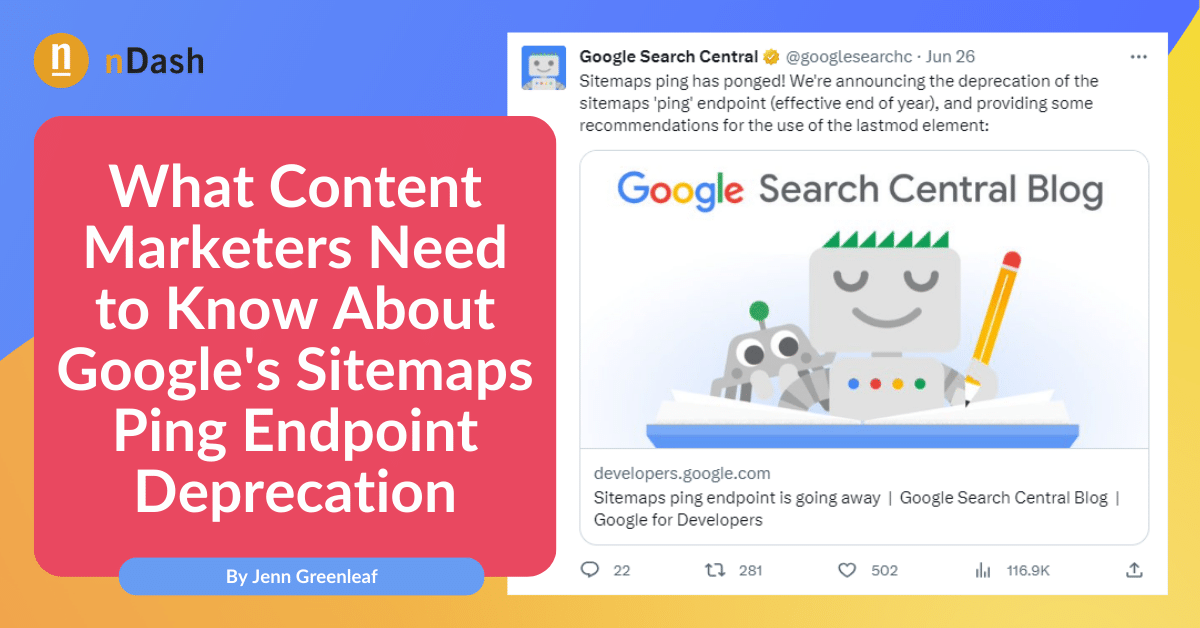Do you have questions about Google’s Sitemaps ping endpoint deprecation? Let’s explore what that is and what content marketers need to know.
Understanding Google’s Sitemaps Ping Endpoint Deprecation

With software and technology, deprecation means a feature or function is no longer supported, resulting in eventual removal. This removal is usually done when a feature is no longer needed or when it’s causing problems.
Google decided to deprecate the sitemaps ping endpoint based on the following factors:
- Most sitemap submissions aren’t very useful. In the case of Google Search, most of the submissions lead to spam.
- Other, more effective ways to notify search engines about new or updated content exist. For example, web admins can submit a sitemap to Google Search Console or include the lastmod tag in the sitemap file.
- Deprecating the sitemaps ping endpoint will help reduce spam and potentially improve the quality of search results.
Google’s Search Central blog update, “You can still submit your sitemaps through robots.txt and Search Console, but the HTTP requests (‘pings’) to the deprecated REST endpoint will result in a 404 error.”
It continues, “Any existing code or plugins which use this endpoint will not cause problems for Google Search; you don’t need to make any changes (but using the endpoint will also not do anything useful).”
Functionality is set to end within the next six months. This timeline means you should stop using the sitemaps ping endpoint immediately.
Implications of the Deprecation for Content Marketers
![[Quote] Google's Sitemaps Ping Endpoint Deprecation](https://www.ndash.com/wp-content/uploads/2023/08/Quote-Googles-Sitemaps-Ping-Endpoint-Deprecation-1024x726.png)
While the deprecation itself may not directly impact website rankings, not correctly submitting sitemaps may lead to content not being crawled and indexed effectively. This error, in turn, can affect a website’s visibility and organic traffic.
As far as SEO strategies go, there will be a few implications content marketers should be aware of in that area as well:
Sitemaps will become less important for indexing:
In the past, sitemap pings could help speed up the indexing of new or updated pages. However, with the deprecation of the endpoint, this will no longer be the case. As a result, sitemaps will become less critical for indexing, and other factors, like internal linking and backlinks, will grow in importance.
The lastmod element will become more important:
The lastmod element in a sitemap tells Google when a page was last modified. With the deprecation of the ping endpoint, Google will rely more on the lastmod element to determine when pages have been updated. As a result, it’s vital to ensure that the lastmod element is accurate for all your pages.
What Google’s update says about the lastmod element is, “You can use a lastmod element for all the pages in your sitemap, or just the ones you’re confident about. For instance, some site software may not be able to easily tell the last modification date of the homepage or a category page because it just aggregates the other pages on the site. In these cases, it’s fine to leave out lastmod for those pages.”
Alternatives for Submitting Sitemaps
Sitemaps help search engines understand a website’s structure and content, which aids in improved indexing and crawling. With the sitemaps ping endpoint deprecation, web admins must rely on alternative methods to ensure proper indexing. Here are some examples:
- Robots.txt: Include a link to your sitemap in robots.txt files. This inclusion tells search engines where to find your sitemap, thus increasing the likelihood of crawling.
- Hreflang tags: If your website is multilingual, use hreflang tags to inform search engines which language versions should be indexed.
- Submit to webmasters’ tools: Most search engines have webmasters’ tools that allow you to submit your sitemap and track its indexing status. These tools can be helpful when ensuring your sitemap is being crawled and indexed correctly.
Ensuring Website Accessibility to Search Engines: Why Content Marketers Should Care
![[Quote] Google's Sitemaps Ping Endpoint Deprecation 2](https://www.ndash.com/wp-content/uploads/2023/08/Quote-Googles-Sitemaps-Ping-Endpoint-Deprecation-2-1024x726.png)
Ensuring that your website remains accessible to crawlers is crucial for maintaining and improving your website’s visibility in search engines. When crawlers can efficiently navigate and index your site, it’s easier for search engines to understand your content, relevance, and authority.
Here are some reasons it’s important:
- Search engine visibility: If your website isn’t accessible to crawlers, search engines may be unable to index your pages correctly, leading to decreased visibility in search results. According to the update, “Any existing code or plugins which use this endpoint will not cause problems for Google Search; you don’t need to make any changes (but using the endpoint will also not do anything useful).”
- New content indexing: When adding new pages or updating existing ones, crawlers must find and index these changes to display them in search results.
- Improved user experience: Optimizing your website’s structure and navigation for crawlers often translates to a better user experience. A well-structured website with easily accessible content benefits search engines and human visitors.
Best Practices For Optimizing Your Website’s Structure and Navigation Improve Crawling
![[Quote] Google's Sitemaps Ping Endpoint Deprecation 3](https://www.ndash.com/wp-content/uploads/2023/08/Quote-Googles-Sitemaps-Ping-Endpoint-Deprecation-3-1024x726.png)
Optimizing your website’s structure and navigation is critical for its success. A well-organized website is easy for search engines to crawl, leading to higher rankings. It’s also easier for users to find the information, potentially leading to increased engagement and conversions.
Here are some best practices for optimizing a website’s structure and navigation:
- Use a logical URL structure: Organize your website’s URLs in a hierarchical and logical manner. Make sure they reflect the content’s hierarchy and categories.
- Create an XML sitemap: Having an XML sitemap is beneficial as it helps search engines discover and index your content efficiently.
- Interlink your pages: Create a well-connected website by including internal links between pages. This practice helps search engine crawlers discover and index content more effectively.
- Implement breadcrumb navigation: Breadcrumb navigation provides a clear path of the page’s location within the website’s structure. It aids both crawlers and users in understanding the page’s context.
- Avoid excessive use of JavaScript for critical content: While search engines have improved in crawling JavaScript, it’s still best to use traditional HTML for essential content to ensure better accessibility.
- Manage duplicate content: Address duplicate content issues to prevent confusion for search engines and maintain a clear indexing process.
- Optimize site speed: Faster-loading websites are preferred by search engines and users alike. Optimize images, enable compression, and leverage browser caching to improve website speed.
Here’s another note from the blog update, “If your CMS changed an insignificant piece of text in the sidebar or footer, you don’t have to update the lastmod value for that page. However, if you changed the primary text, added or changed structured data, or updated some links, do update the lastmod value.”
Tips for Monitoring and Maintaining Sitemap Files and Website Content
There’s no such thing as “set it and forget it” when building a website and posting content.
Monitoring and maintaining sitemap files and your website’s content is essential for ensuring its health, visibility, and optimization. Here are some tips to help content marketers with these tasks:
- Update XML sitemaps regularly: Whenever you add or remove content, update your XML sitemap and submit it to search engines.
- Monitor crawl errors: Leverage webmaster tools to identify and fix crawl errors on your website.
- Check for broken links: It’s frustrating for your site’s visitors when they click a link and it doesn’t work. Regularly scan for broken links and fix them promptly.
- Review analytics data: Monitor your website’s performance through analytics to identify any sudden drops in traffic or indexing issues.
- Keep content fresh: Regularly update and add content. This tactic encourages search engines to crawl your site more frequently.
How Content Marketers Can Leverage Other SEO Tools and Features

SEO tools can be valuable for website owners who need to improve performance and ranking. Here are some popular SEO tools and how content marketers can leverage them:
- Google Search Console: Receive insights into how your website performs in Google Search. Track your keyword rankings, identify technical errors, and monitor backlinks.
- Google Trends: This tool tracks which search terms are popular over time. Tracking can help you with keyword research and identify trends that may impact website traffic.
- Google Analytics: Receive detailed information regarding how visitors interact with your website. Leverage this data to improve the user experience and boost your SEO performance.
- Bing Webmaster Tools: This tool offers insights into your website’s performance in Bing’s search results.
In addition to these tools, several third-party SEO tools are available:
- Ahrefs: Gain access to features like keyword research, backlink analysis, and site auditing.
- SEMrush: Another popular all-in-one SEO tool, SEMrush offers several features, including keyword research, competitor analysis, and content marketing tools.
- Moz: This tool is known for its in-depth keyword research, link building, and on-page SEO analysis.
- Majestic: Use this tool for backlink analysis and its other features for identifying and monitoring backlinks.
- Screaming Frog: This site crawler is invaluable for identifying technical errors and other issues hindering a website’s performance.
Beyond Sitemaps: New Approaches for Content Marketers in the Wake of Google’s Update
While sitemaps have been vital in expediting indexing, focusing on alternative methods like robots.txt, hreflang tags, and user experience become more important.
Embracing these new approaches will ensure the continued success of websites and strengthen their presence in the dynamic landscape of search engine optimization.

